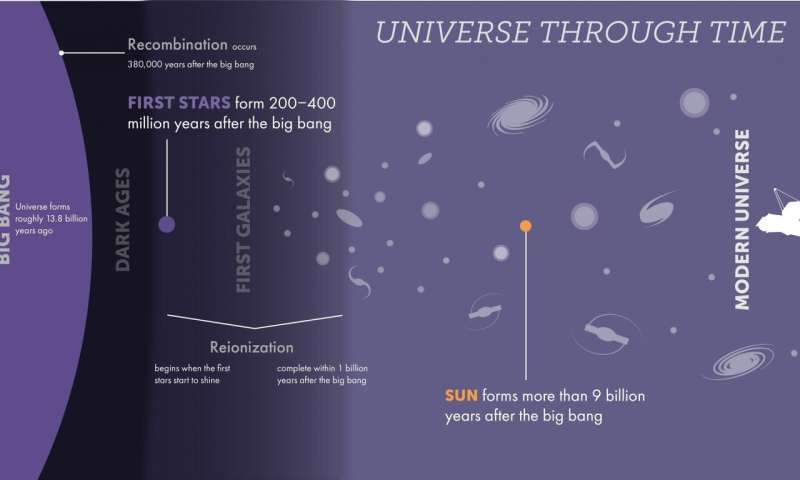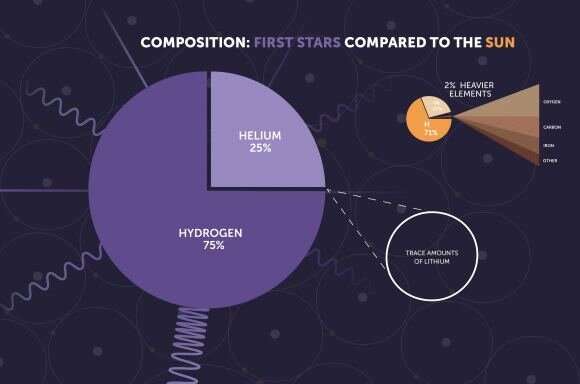The distance of first generation stars. Credit: STScI
All stars are composed of mostly hydrogen and helium, but most stars also have measurable amounts of heavier elements, which astronomers lump into the category of "metals." Our sun has more metals than most stars because the nebula from which it formed was the remnant debris of earlier stars. These were in turn children of even earlier stars, and so on.
Generally, each new generation of stars has a bit more metal than the last. The very first stars, those born from the primordial hydrogen and helium of the cosmos, had almost no metal in them. We've never seen one of these primordial stars, but with the power of the Webb and a bit of luck, we might catch a glimpse of them soon.
One way to determine the amount of metal a star has is by comparing the ratio of iron in its atmosphere compared to helium, known as [Fe/He]. This metallicity number is usually expressed on a logarithmic scale, where the sun's metallicity is set to zero. Stars are then set into populations based on this number. Any star with a metallicity of at least -1 (meaning it has at least 10% of that of the sun) is a Population I star. Stars with lower metallicity are Population II stars, and the very first stars with no observable metals would be Population III stars.
In the Milky Way, Population I stars are typically found within the galactic plane and spiral arms, while Population II stars are mostly in a more diffuse halo of stars surrounding the galaxy. This makes sense, since stars form within the gas and dust of spiral arms, and can drift away from the galactic plane as they age. Other than the fact that Population II stars are usually billions of years older than the sun, they are broadly similar to younger stars.
A Population III star compared to our sun. Credit: STScI
The first generation of stars is thought to have been very different. The more metal a star has the more dense it can be. A star such as the sun is more compact than a Population III star, and therefore doesn't need as much mass to shine so brightly. Since the first stars were made only of hydrogen and helium, we think they were massive stars that lived short but very luminous lives. They likely formed during the first few hundred million years of the universe, and died within a few tens of million years or less. The only way we can see their light is by peering into the deepest reaches of space. Even the brightest galaxy of Population III stars would be very dim as seen from Earth. But are they too dim for the almighty Webb to observe?
That's the question this recent study, available on the preprint server arXiv, tried to answer. The team simulated both the intensity and spectrum of first-generation stars to determine how they might appear within an early galaxy, then compared this to the capability of the Webb Space Telescope. They found that if Webb had a direct, unobstructed view of a bright primordial galaxy, it would still be too dim for Webb to see. But if a particularly large primordial galaxy happens to be located behind a large closer galaxy, gravitational lensing could magnify and brighten the distant galaxy's light to a point where Webb could detect it.
In other words, we are on the frustrating edge of being able to detect first-generation stars. If things are lined up just so, and we can separate the spectra of the first-generation galaxy from the closer galaxy, then we have a chance. That may sound disappointing, but astronomers are skilled and clever, so there's reason to hope that in time we will see light from the grandmothers of all stars.
More information: James A. A. Trussler et al, On the observability and identification of Population III galaxies with JWST, arXiv (2022). DOI: 10.48550/arxiv.2211.02038
Journal information: arXiv
Provided by Universe Today

























